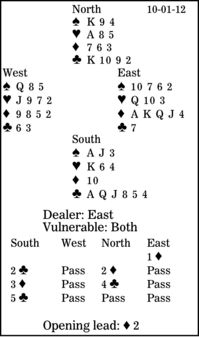Bridge column, October 1: Would you prefer one chance or two?

There are different chances at the bridge table. In principle, whenever you take a finesse, you give yourself a 50 percent chance of an extra trick. If you have a suit like A-J-10 opposite x-x-x, you can take two finesses and have a 76 percent chance of two tricks.
In today's deal, South is in five clubs. The defenders start with two rounds of diamonds. Declarer will lose a diamond and a heart. Can he do better than relying on the spade finesse?
North's two-diamond cue-bid showed club support with at least game-invitational values. South's three-diamond cue-bid asked his partner to bid three no-trump with a diamond stopper. When North denied a stopper, South went for five clubs.
It is easy to rely on the spade finesse because it is likely to win; after all, East opened the bidding. But there is a better plan. South ruffs the second diamond, draws trumps ending on the board, ruffs the last diamond, and plays three rounds of hearts, giving an opponent the lead. What happens?
If West is on play, he must either lead a spade into the ace-jack or concede a ruff-and-sluff, on which South's spade loser evaporates.
If East takes the heart trick and shifts to a low spade, South plays low from his hand. Here, West has to play the queen, so the contract makes. But if West could play the 10, declarer would win on the board and play a spade to his jack. He succeeds whenever East has the 10 or queen.
** ** **
COPYRIGHT: 2012, UNITED FEATURE SYNDICATE
DISTRIBUTED BY UNIVERSAL UCLICK FOR UFS

